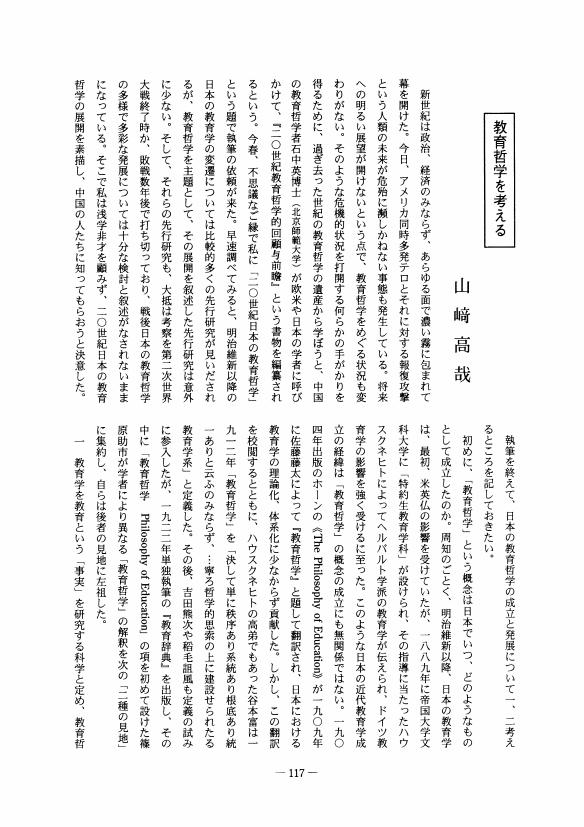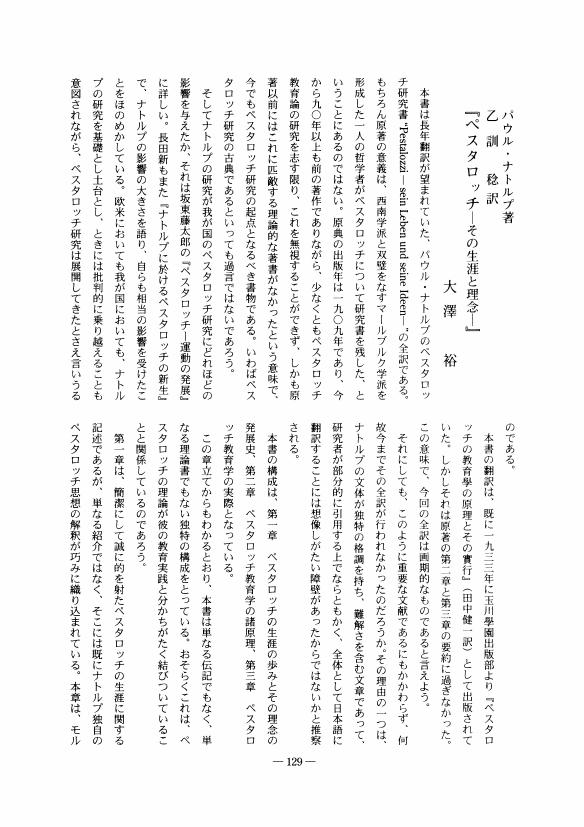1 0 0 0 OA ゲルハルト・ツェヒャ編『批判的合理主義と教育論議』
- 著者
- 青木 英実
- 出版者
- 教育哲学会
- 雑誌
- 教育哲学研究 (ISSN:03873153)
- 巻号頁・発行日
- vol.2001, no.84, pp.146-150, 2001-11-10 (Released:2009-09-04)
1 0 0 0 OA 榑松かほる著『小泉郁子の研究』
- 著者
- 影山 礼子
- 出版者
- 教育哲学会
- 雑誌
- 教育哲学研究 (ISSN:03873153)
- 巻号頁・発行日
- vol.2001, no.84, pp.151-152, 2001-11-10 (Released:2009-09-04)
1 0 0 0 OA クリストフ・ヴルフ編著高橋勝 監訳『教育人間学入門』
- 著者
- 森田 孝
- 出版者
- 教育哲学会
- 雑誌
- 教育哲学研究 (ISSN:03873153)
- 巻号頁・発行日
- vol.2001, no.84, pp.153-154, 2001-11-10 (Released:2009-09-04)
1 0 0 0 OA 〈他者〉との出会いとしての共生 教育にとっての示唆
- 著者
- 土戸 敏彦
- 出版者
- 教育哲学会
- 雑誌
- 教育哲学研究 (ISSN:03873153)
- 巻号頁・発行日
- vol.2002, no.85, pp.1-5, 2002-05-10 (Released:2010-05-07)
- 参考文献数
- 5
1 0 0 0 OA 共生と教育の二つのかたち
- 著者
- 矢野 智司
- 出版者
- 教育哲学会
- 雑誌
- 教育哲学研究 (ISSN:03873153)
- 巻号頁・発行日
- vol.2002, no.85, pp.6-10, 2002-05-10 (Released:2009-09-04)
- 参考文献数
- 4
1 0 0 0 OA 自己形成的トポスとしての「教室という社会」の再構築 「共生」に基盤をおく道徳教育の可能性
- 著者
- 渡邉 満
- 出版者
- 教育哲学会
- 雑誌
- 教育哲学研究 (ISSN:03873153)
- 巻号頁・発行日
- vol.2002, no.85, pp.11-15, 2002-05-10 (Released:2009-09-04)
- 参考文献数
- 11
1 0 0 0 OA 道徳の普遍的法則に基づく教育の可能性 愛国者と世界公民
- 著者
- 倉本 香
- 出版者
- 教育哲学会
- 雑誌
- 教育哲学研究 (ISSN:03873153)
- 巻号頁・発行日
- vol.2001, no.84, pp.71-86, 2001-11-10 (Released:2009-09-04)
- 参考文献数
- 27
周知のように、カントは道徳理論において、ア・プリオリに自ら立法した道徳法則に従って自己規定する主体が自律的主体であることを明らかにしたが、カントが一七七六年から一七八七年にかけて断続的に行った教育学講義からは、カントが教育の中心は道徳的陶冶にあり、その最終目的は世界公民的見地から世界福祉に関心を持つ人間、即ち、世界公民の育成にあると考えていたことを読みとることができる.つまり、カントの教育論はカントが道徳理論で明らかにした自律的主体の形成理論として解することができるのである。その際、カントが自らの教育理論を実践するものとして評価した汎愛派のバゼドウとの思想的連関に着目してみたい。カントが教育学の講義でバゼドウの著書を教科書として使用し、さらにカントがバゼドウの汎愛学舎を支援したことは有名なエピソードであるが、当時の学校には根本的な欠陥があると考えていたカントにとって、体罰や無意味なコトバ知識の暗記に頼った従来の教育方法を批判して「人間の友 (Menschenfreunde) 」としての実践的市民の育成という教育理念を掲げたバゼドウの学校は、「自然にも全公民の目的にも適合した教育施設」 (II 447) と思えたようである。しかし、「明らかに徹底的に堕落している」学校教育の改革構想を世に問うたバゼドウが目指したのは、人間の友としての実践的市民、即ち「愛国者 (Patriot) 」の育成であり、カントが目指したのは世界公民の育成であった。すると次のことが問題となってくる。カントが愛国者の育成を目指したバゼドウを評価するのはなぜか、愛国者への教育と世界公民への教育はいかにして両立し得るのか、という問題である。従来ほとんど着目されることがなかったカントとバゼドウの思想的連関について本論文ではこのような観点から考察し、以下のことを明らかにしてみたい。 (1) カントとバゼドウの接点は、道徳的品性樹立のための指導者への服従・従順という「徳の訓練」を重視する点において認められるが、「徳の訓練」は「法則的強制への服従と自由の使用とを結合」 (IX 453) して自律的な実践的主体を形成するためのものとされること、 (2) 世界公民である自律的・実践的主体を同時に愛国者にもなし得るためには反省的判断力の原理が不可欠であるが、しかし (3) ア・プリオリな普遍的法則と反省的判断力との協働は、カントが考えた、自己の行為の道徳性を判定する厳密な基準を「あたかも道徳的であるかのように」合目的的に考えられた別の基準にすり替えてしまうことに等しく、そのために、本来ならば道徳法則に従う自律的な世界公民のための教育が、自己を「あたかも道徳的であるかのように」思いこむだけのたんなる愛国者の育成となってしまう可能性があることを指摘する。 (4) そして最後に、ア・プリオリな道徳法則によってのみ意志が規定されるというカント実践哲学の基本的枠組みを再度見直し、道徳性の超越的な基準とともに普遍的法則を自らに対して与えるということが自由な行為の可能性の制約そのものであり、この制約によってのみ世界公民への教育が可能となることを確認したい。
1 0 0 0 OA J・A・コメニウスにおける事物主義と図絵 一七世紀普遍言語構想における言葉と事物
- 著者
- 北詰 裕子
- 出版者
- 教育哲学会
- 雑誌
- 教育哲学研究 (ISSN:03873153)
- 巻号頁・発行日
- vol.2001, no.84, pp.87-103, 2001-11-10 (Released:2009-09-04)
- 参考文献数
- 61
This paper attempts to describe Jan Amos Comenius' cognition of “things” with special reference to language and picture in the Universal Language Schemes, schemes that typically present relations between things and words in the 17th century. For that purpose we compare Comenius and John Wilkins, his contemporary, who had influenced each other.Comenius supposed that “things” themselves are concrete presentations of Ideas. In contrast, Wilkins thought that things might be composed of “notions”. This difference divides their forms of Universal Language into concrete “picture” and abstract “character”, respectively.While Comenius tried to represent “things themselves” visually as Universal Language in the form of picture, Wilkins tried to represent “things as constructed from notion” by Real Character as Universal Language.Complying with each belief, Comenius and Wilkins on the contrary tried to tie things with words that had been commonly dissociated each other, and tried to represent them in a set of correct order. In this rational representation of the world, Comenius's pedagogical approach has been located in the modern educational context.
1 0 0 0 OA 教育実践理論への「超越論」的視座
- 著者
- 市村 尚久
- 出版者
- 教育哲学会
- 雑誌
- 教育哲学研究 (ISSN:03873153)
- 巻号頁・発行日
- vol.2001, no.84, pp.104-116, 2001-11-10 (Released:2009-09-04)
哲学にとってまことに不面目なことは、初めから人間と世界との間には裂け目が存在するものと、これまで誰もが真面目に信じてきたということである。生きられた現実のなかでは、こうした裂け目は擬似問題である。-L・H・トルートナー「ジョン・デューイと実存的現象学者」-
1 0 0 0 OA 教育哲学を考える
- 著者
- 山崎 高哉
- 出版者
- 教育哲学会
- 雑誌
- 教育哲学研究 (ISSN:03873153)
- 巻号頁・発行日
- vol.2001, no.84, pp.117-118, 2001-11-10 (Released:2009-09-04)
1 0 0 0 OA 坂越正樹著『ヘルマン・ノール教育学の研究-ドイツ改革教育運動からナチズムへの軌跡-』
- 著者
- 高橋 勝
- 出版者
- 教育哲学会
- 雑誌
- 教育哲学研究 (ISSN:03873153)
- 巻号頁・発行日
- vol.2001, no.84, pp.119-125, 2001-11-10 (Released:2009-09-04)
1 0 0 0 OA 杉山精一著『初期ヘルバルトの思想形成に関する研究-教授研究の哲学的背景を中心として-』
- 著者
- 鈴木 晶子
- 出版者
- 教育哲学会
- 雑誌
- 教育哲学研究 (ISSN:03873153)
- 巻号頁・発行日
- vol.2001, no.84, pp.126-130, 2001-11-10 (Released:2009-09-04)
1 0 0 0 OA 田端健人著『「詩の授業」の現象学』
- 著者
- 藤井 千春
- 出版者
- 教育哲学会
- 雑誌
- 教育哲学研究 (ISSN:03873153)
- 巻号頁・発行日
- vol.2001, no.84, pp.131-136, 2001-11-10 (Released:2009-09-04)
この著は、著者・田端健人氏が、一九九八年九月に、東京大学大学院教育学研究科に提出した学位請求論文「ハイデッガーの詩作的思索による詩の授業の解明」を補筆・修正したものである、本著では、田端氏の研究テーマ、すなわち、詩や文学作品を教材とした国語の授業において、子どもは語句の意味調べや要約や印象的な鑑賞の次元を超えて、どのようにして作品と出会うのか、作品の世界を「共感的」に生きるとはどのようなことかという問題について、教育実践に基づき、個々の授業での子どもや教師の言葉や活動に即して具体的に究明することがめざされている。
1 0 0 0 OA 増渕幸男・森田尚人編『現代教育学の地平-ポストモダニズムを超えて-』
- 著者
- 宮寺 晃夫
- 出版者
- 教育哲学会
- 雑誌
- 教育哲学研究 (ISSN:03873153)
- 巻号頁・発行日
- vol.2001, no.84, pp.137-145, 2001-11-10 (Released:2009-09-04)
1 0 0 0 OA 俵木浩太郎著『平和の哲学-孔子からユネスコへ』
- 著者
- 宇野 美恵子
- 出版者
- 教育哲学会
- 雑誌
- 教育哲学研究 (ISSN:03873153)
- 巻号頁・発行日
- vol.2001, no.83, pp.123-124, 2001-05-10 (Released:2009-09-04)
1 0 0 0 OA 沼田裕之・加藤守通編著『文化史としての教育思想史』
- 著者
- 坂倉 裕治
- 出版者
- 教育哲学会
- 雑誌
- 教育哲学研究 (ISSN:03873153)
- 巻号頁・発行日
- vol.2001, no.83, pp.125-126, 2001-05-10 (Released:2009-09-04)
1 0 0 0 OA 教育思想史学会編『教育思想事典』
- 著者
- 舟山 俊明
- 出版者
- 教育哲学会
- 雑誌
- 教育哲学研究 (ISSN:03873153)
- 巻号頁・発行日
- vol.2001, no.83, pp.127-128, 2001-05-10 (Released:2009-09-04)
1 0 0 0 OA パウル・ナトルプ著乙 訓 稔訳『ペスタロッチ-その生涯と理念-』
- 著者
- 大澤 裕
- 出版者
- 教育哲学会
- 雑誌
- 教育哲学研究 (ISSN:03873153)
- 巻号頁・発行日
- vol.2001, no.83, pp.129-130, 2001-05-10 (Released:2009-09-04)
1 0 0 0 OA 超越の亡失 教育をめぐる反時代的考察
- 著者
- 岡田 渥美
- 出版者
- 教育哲学会
- 雑誌
- 教育哲学研究 (ISSN:03873153)
- 巻号頁・発行日
- vol.2001, no.84, pp.1-18, 2001-11-10 (Released:2009-09-04)
There has never been such a period as today when almost all issues and aspects of education appear to be enthusiastically discussed, when lots of records and documents have been accumulated and equipped educators and academics with abundant information, and when various kinds of practical efforts have been made and new pedagogic methods have been actively experienced. Nevertheless, education is, indeed, losing its substantiality. For it has decayed and deteriorated into 'formalism' as its philosophy has been regarded as unpractical, and therefore, insignificant and largely negligible. People's skepticism towards philosophy of education has, it seems, led them to heated, yet self-exhaustive, discussions on education. Any argument or effort is bound to be ineffective and of little importance unless it is our own existential volition. Our wasted efforts for educational reforms, as well as the unsatisfactory status-quo surrounding education, originate presumably in the lack of our 'transcendental' vision of education. For education lies in our appraisal of the traditional vision of the sound human world. The chapters dealing with the following issues shall demonstrate my thesis : 1. Preliminary Consideration2. The Age of Bewilderment3. Poverty in Prosperity4. The Crisis of Education5. Education and the Transcendental Viewpoint6. Oblivion and Renaissance of Transcendency
1 0 0 0 OA 東洋思想と人間形成 井筒俊彦の理論地平から
- 著者
- 西平 直
- 出版者
- 教育哲学会
- 雑誌
- 教育哲学研究 (ISSN:03873153)
- 巻号頁・発行日
- vol.2001, no.84, pp.19-37, 2001-11-10 (Released:2010-05-07)
- 参考文献数
- 32
The so-called Postmodern philosophy is the philosophy of de-construction wherein the ontological basis of the modern human sciences has been destroyed. We have to look for a new perspective of Life Cycle. This paper tries to find a new framework from Eastern philosophy. Eastern philosophy is a philosophy of de-construction, but it is a philosophy of re-construction as well. The category of “Eastern philosophy” in this paper is strictly limited to the wording of Toshihiko lzutsu. In a word, this paper intends to re-construct the way we perceive child development from the perspective of Eastern philosophy as structured by lzutsu.In order to simplify my discussion, I made a chart which illustrates three processes;Process A is the way to construction, or the way of child development, in which he/she establishes the ego, acquires the language, and makes boundaries through the grid of language. (Izutsu called this grid “semantic articulation”).Process B is the way to de-construction, or “Oh-so (往相) in Buddhism. This is the way in which one leaves from the ego, loses boundaries through dissolving the grid of language, and becomes more subtle and fluid.Process C is the way to re-construction, or” Gen-so (還相) in Buddhism. This is the way in which one returns to the world of ordinary consciousness, but in “a double perception”. Through this process individual phenomenal beings are recovered. But those who have once experienced the state of no-boundary are so radically transformed that they never forget a viewpoint of no-boundary. In this sense, the perspective of Eastern philosophers can be called 'a double perception'.Eastern philosophers (the sages who have once experienced “Non-Being” and came back to the ordinary consciousness) open for us a possibility to see children in two different dimensions, i.e., as those determined by our ordinary boundaries, and as those completely free from all boundaries. What kind of image of children do Eastern philosophers suggest to us in their 'double perception'? What do they teach us about the different phases of child development which we cannot recognize within our ordinary 'single perception'? This is the starting point to read anew Eastern philosophers' texts from the viewpoint of child development or Life Cycle.













